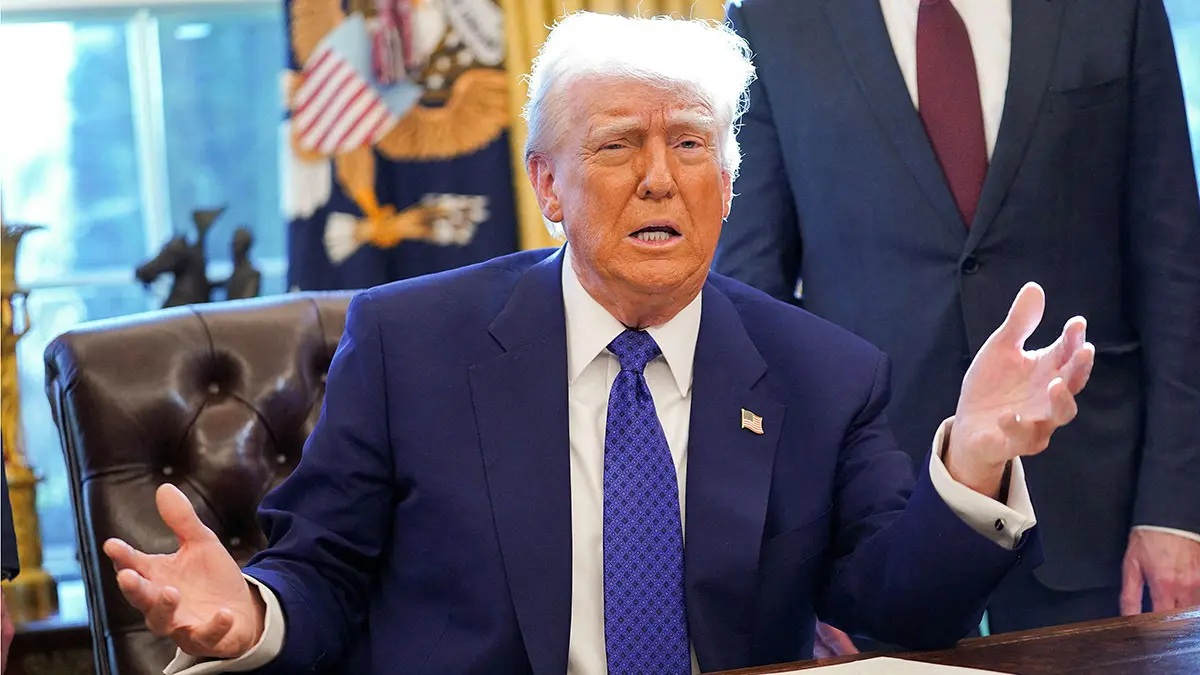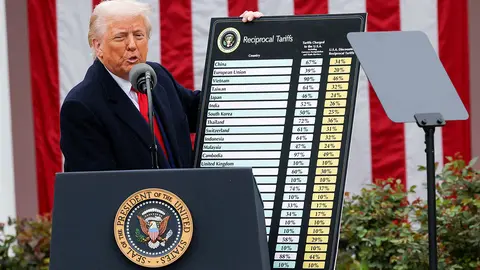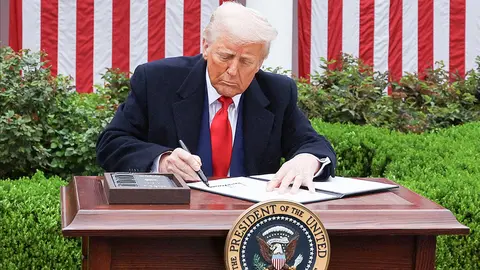Trump shakes up the bond market and sends shivers down Europe's spine

In just three days, stock markets in Europe posted their biggest losses since the COVID-19 pandemic broke out in March 2020.
On 7 April alone, in three hours of trading, European stock markets saw 870 billion dollars evaporate, it was a real Black Monday; and almost two trillion dollars' worth of investment promises from various global companies have been put at risk.
Uncertainty, combined with volatility, plus the panic unleashed by the tariff policy of the new US government, has led to speculation that is punishing the stock markets; commodities such as Brent oil have plummeted to 60.17 dollars per barrel and gold is rising towards the clouds, very close to 3,200 dollars an ounce.
Everything is upside down. And, in the currency market, the dollar is following the strategy intended by President Donald Trump: to weaken the greenback against the euro and the pound sterling.
But it is not the stock market, nor the currency market, that has set off all the alarms among the European central banks, which in recent days have placed special emphasis on the perfect financial storm that can be created through Treasury bonds.
Some are already warning of the chaos and drama of playing with risk aversion; even Elon Musk, the tech mogul who is part of the new US government, is gnashing his teeth at the negative consequences of such high tariffs.
There is a whole internal debate among gurus and academics analysing the bearish, almost recessionary, course that awaits the US economy, while Eurozone countries readjust their growth prospects downwards.
US economist Paul Krugman adds spice to the debate in an interesting analysis entitled ‘The Cost of Chaos: This is Getting Scary’, in which he points out how Trump's erratic policies have increased the risk of recession: ‘We have higher tariffs than Smoot-Hawley in less than three months’.
But this has already escaped Trump's grasp like smoke. It is no longer merely a matter of the commercial impact of tariffs, levies and markets. Investors are scared and this mass movement away from uncertainty is causing disturbances in the stock and currency markets; the greatest fear lies in the financial world because the damage could be incalculable. Trump hasn't gauged it well, and although he believes himself to be all-powerful, he may not be able to put the devils in the box as quickly as expected.
Krugman, who has received several awards, quotes Austan Goolsbee, president of the Chicago Federal Reserve, emphasising that higher tariffs will have more impact on domestic inflation in the United States. And it's not just consumers' pockets that are going to suffer.
‘Equilibrium rates can be altered; the differential between the interest rates of bonds that are indexed to consumer prices and bonds that are not. This differential can normally be seen as an implicit prediction of how much consumer prices will increase’, explains Krugman.
What is happening right now with Treasury bonds? Investors are selling their positions, affecting their price and forcing their yield to rise.
‘In doing so, they alter the equilibrium rate because the index-linked bond market is relatively small and scarce, the rush to sell has a greater effect on depressing prices and increasing interest rates for index-linked bonds than for ordinary bonds. And, this is not the first time it has happened; it already happened in the financial crisis in 2008 and 2009; and during the pandemic,’ the writer points out.
Krugman is very serious when he points out that the media is only paying attention to the stock market roller coaster while the ‘truly terrifying’ thing is in the bond market.
Confidence indicator
Why are Treasury bonds so important? Basically, they are a barometer of confidence in the US economy; these long-term debt securities issued by the US Treasury Department play a crucial role in the global financial market, as they provide governments with a reliable source of financing for various projects and public spending.
They also serve as a benchmark for interest rates and are used by investors to assess the risk of other investments. Treasury bonds are considered a basic component in a well-diversified investment portfolio, as they can offer stability and income with minimal risk; and they tend to have long-term maturities ranging from 10 to 30 years.
And they are significant because they act as a safe haven, like gold, in times of uncertainty; however, this bond market is not reacting as Trump expected it to or as it traditionally used to: if the stock market fell and the dollar weakened, investors moved favourably to buy more Treasury bond investments, which raised their price and kept long-term interest rates low.
In recent days this has not happened and it has been interpreted as a dangerous sign that in the trade war unleashed by Trump some holders of these bonds, which are used to finance the US debt, are massively selling their holdings, which has caused their price to plummet and led to a sharp rise in yields. Trump doesn't want to make US debt more expensive, but cheaper, but in two days he managed to do just the opposite.
Who is selling their Treasury bonds in retaliation against the White House tenant? In Europe, they are looking sideways at China and even Canada; in fact, the German Deutsche Bank went so far as to declare that if the situation was not contained, the Federal Reserve would have to urgently intervene in the bond market to bring it back to a point of equilibrium.
How much US debt do foreign countries hold? The Treasury Department indicates that, in April last year, 22.9% of the total US debt was in foreign hands; approximately 7.9 trillion dollars.
In the last 20 years, Japan and China have owned more US Treasury bonds than any other foreign nation: between December 2000 and April 2024, Japan's holdings rose from 556.3 billion dollars to just over 1.1 trillion dollars. China's holdings grew from 105.6 billion dollars to 749 billion dollars; it is followed by the United Kingdom with 690.2 billion dollars; Luxembourg with 373.5 billion dollars and Canada with 328.7 billion dollars.
Between 2003 and 2011, Japan and China held 44% or more of all US foreign-held debt. However, this proportion has declined over time and, as of 2023, they controlled approximately 25% of foreign-held debt.
The Treasury Department confirmed that, over the last nine months, the Chinese government carried out a series of sales of its Treasury bonds gradually each month.



